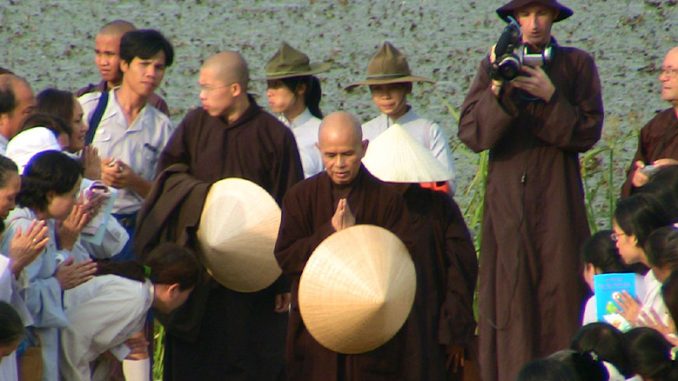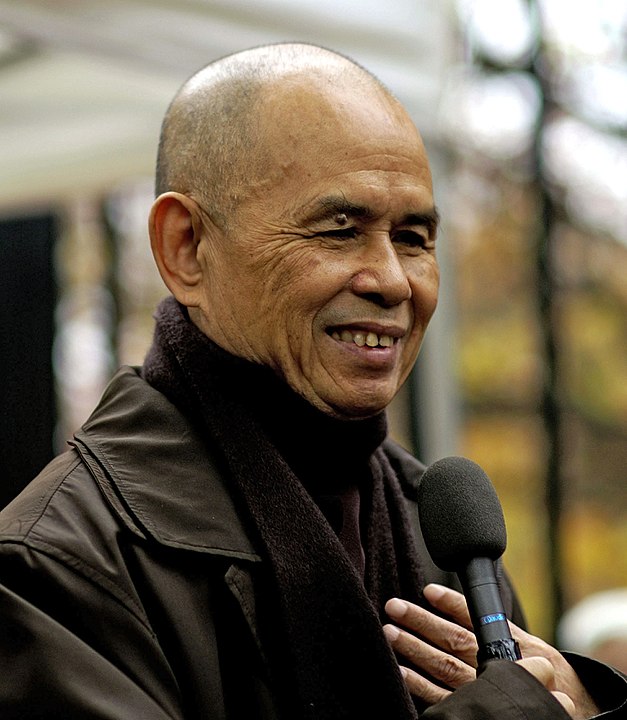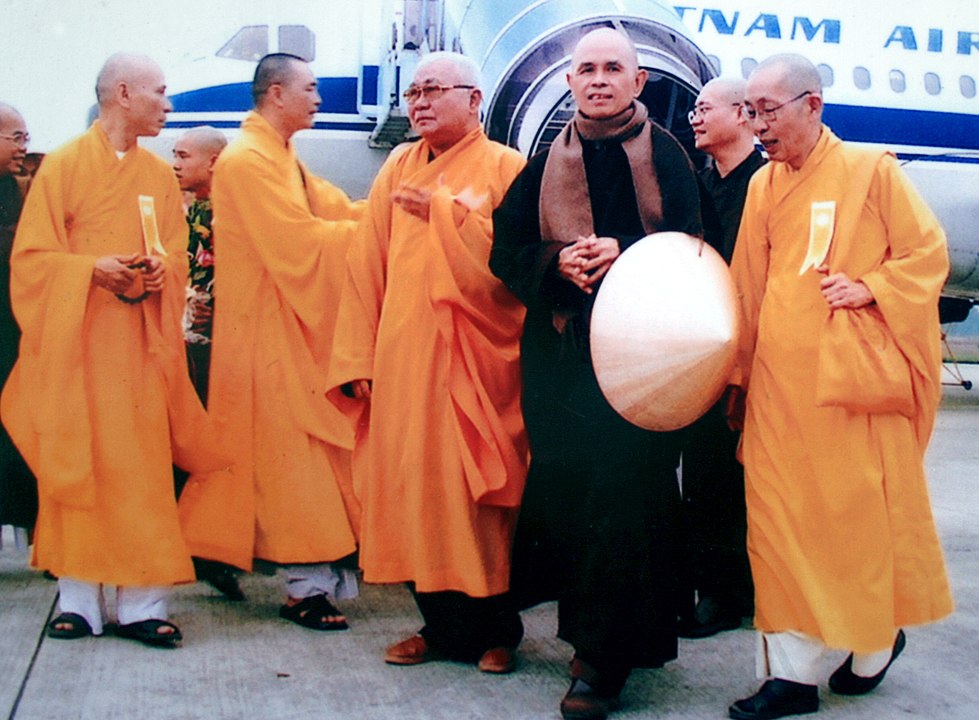
The southern Vietnamese Buddhist movement of the 1960s is often remembered through images of protest: people marching with banners and monks self-immolating on city streets. Buddhists were the largest organized dissident group in the Republic of Vietnam (RVN), most well-known for the 1963 “Buddhist crisis” when thousands took to the streets to protest official policies and demand representative government. 1 To American advisors, this crisis served as proof of President Ngô Đình Diệm’s inability to rule; he was ousted by a CIA-backed military coup later that year. Historians have written about the strength and influence of the Buddhist movement including Robert Topmiller, James McAllister, Edward Miller, and Sophie Quinn-Judge. 2 However, scholarship on the historical and intellectual foundations of the movement, as well as its internal dynamics and vision, is sparse.
In an effort to shed more light on the ideas behind the Buddhist movement, this essay explores the writings of one influential monk, Thích Nhất Hạnh (1926-2022), who advocated socially engaged Buddhism as a form of nonviolent patriotism and nation-building. Throughout his early life in central and southern Vietnam, Thích Nhất Hạnh observed that traditional Buddhism, isolated in temples, was not addressing the worldly concerns of the people. 3 To remain relevant and of service during civil war, Buddhist leaders had to engage with societal suffering. Between the late 1950s and mid-1960s, Thích Nhất Hạnh tried and gave up on efforts to reform traditional Buddhist institutions and turned instead toward youth as agents of social change. In Saigon, he founded a school for Buddhist education and social work, hoping to empower the next generation to change course: instead of waging war, they could build their country through social service and nonviolent reconciliation. While fellow dissident Buddhists concerned themselves with anti-government and anti-war protests, Thích Nhất Hạnh was the only monk to organize a youth movement with a positive, long-term vision for Vietnamese Buddhism and nationalism.

Advocating Unified, Engaged Buddhism in Vietnam
The idea of socially engaged Buddhism arose as part of the early twentieth century Buddhist revival which unfolded across Asia. Like others in his generation, Thích Nhất Hạnh was strongly influenced by this revival movement. 4 He began writing about engaged Buddhism in the 1950s, advocating institutional reforms and later inspiring a youth movement in the spirit of social service.
Thích Nhất Hạnh wanted Buddhist institutions to serve their war-torn country and contribute to the construction of a peaceful, independent Vietnam. He advocated passionately for reforms he believed would enable nationally coordinated Buddhist action. His hopes are captured in the journal Vietnamese Buddhism [Phật Giáo Việt Nam], for which he served as editor-in-chief from 1956 through 1958. This was the official journal of the General Buddhist Association [Tổng Hội Phật Giáo Việt Nam] – an organization formed in 1951 that unified six Buddhist groups in central and southern Vietnam.
Writing in his capacity as editor-in-chief and under the pen name Dã Thảo, Thích Nhất Hạnh criticized the unwillingness of Buddhist leaders to truly unify and mobilize for the benefit of society. He laid out reforms he believed were necessary, including welcoming all Buddhist groups into the General Buddhist Association, standardizing monastic teaching, programming, and clothing across regions, and centralizing leadership and finances. 5 In doing so, he adopted the language of an activist rather than the measured tone of an official editor. All Buddhists, he wrote, “must accept true harmony as the most urgent task of our time. Buddhism is a force for peace, and the General Buddhist Association is our united front.” 6 He dramatically called on Association leaders to act: “Your names will be written in the history of Vietnamese Buddhism… Millions of eyes are upon you, dear friends. Live up to your reputation as bright leaders and do not disappoint your devotees.” 7
In using the General Buddhist Association’s journal to criticize its own leadership, Thích Nhất Hạnh may have overstepped his role as editor-in-chief. He went as far as publishing a letter writing campaign that encouraged readers to pressure the General Buddhist Association to enact reforms. 8 The journal was discontinued after two years, with the official reason being a lack of funds. Thích Nhất Hạnh was convinced, however, that Association leaders stopped publishing the journal because they wanted to put an end to his criticisms and advocacy. He experienced the journal’s shutdown as a stark rejection of his ideas, and as a great loss of potential for Vietnamese Buddhism at large. 9
In Thích Nhất Hạnh’s eyes, the unique potential of Vietnamese Buddhism was going to waste because its leaders were content with simply performing traditional ceremonies. They were not utilizing their networks and influence to address the urgent needs of their communities. “A sermon in a suffering community means nothing,” he later wrote, describing the ideal role of engaged Buddhism. “The real sermon needed is action, the kind of action that can realistically stop the suffering being endured.” 10 After his ideas for institutional reform and mobilization were ignored and rejected by monastic leaders, Thích Nhất Hạnh shifted his focus and hopes to a new set of actors: young Buddhists.

Buddhist Youth and Nation-Building
In the early 1960s, Thích Nhất Hạnh began organizing and appealing to Buddhist youth to lead the way toward a peaceful and prosperous Vietnamese society. In a series of articles entitled “Speaking to Youth in Their Twenties” [“Nói Với Tuổi Hai Mươi”], he called on readers to take charge of a new, pacifist revolution. He imagined that the next generation was thirsty for solutions and had the strength and energy to make real change.
“Speaking to Youth” was published in the journal Preserving the Fragrance of the Motherland [Giữ Thơm Quê Mẹ] in eight parts, each focusing on a different theme: loneliness [cô đơn], ideals [lý tưởng], academic studies [học hành], love [thương yêu], and religion [tôn giáo]. The articles alternated between gentle discussions of everyday concerns and fiery calls to action. Thích Nhất Hạnh seems to have wanted to both soothe and galvanize young people who were finding their way through life under civil war. He wanted them to feel understood, and to inspire them to reject the war and its power structures. National peace would begin with the next generation’s choice to act out of love and compassion. “If you know how to love and forgive, then the spirit of our country will be awakened… the guns and bullets will breathe a sigh of relief, the airplanes will weep, the grenades will go silent, and our homeland will be a battlefield no more.” 11
The series encouraged youth to stand up to the authorities responsible for war, without resentment, and to take the lead in creating a new society. “Only the collective action of the youth… has the power to dismantle the conscious and unconscious structures of society,” he claimed. Channeling this vision into concrete action, Thích Nhất Hạnh founded a school where college-aged students would study religion and social work before leading humanitarian aid and development projects in the countryside.
The School of Youth for Social Service (SYSS) [Trường Thanh Niên Phụng Sự Xã Hội] was founded in Saigon in 1964. Its students were trained to do rural development work including digging wells, teaching literacy, providing basic medical care, and introducing new farming methods. They also brought aid to places affected by bombing and floods. The goal was to empower Buddhist youth to take the future of Vietnam into their own hands; they would build their ideal country one household, school, and village at a time. 12 The SYSS relied on Buddhist temples to connect its students with villages throughout central and southern Vietnam. “Religion should be a connector, not something authoritarian that divides people from one another,” Thích Nhất Hạnh wrote, perhaps alluding to his experience with the General Buddhist Association. 13
The scale of these youth-led relief and development projects was small – fewer than ten thousand graduated from the SYSS in its decade of life – yet they were an expression of Thích Nhất Hạnh’s broader vision of nation-building. The school was a grassroots movement, driven by engaged Buddhist principles, that sought to build a spiritual and material foundation for Vietnam. There was no way to know whether engaged Buddhist efforts like the SYSS would bring about the large-scale political and spiritual changes Thích Nhất Hạnh believed were necessary. But he knew they could not rely on slow-moving religious institutions or a government determined to build a nation through waging war. “The School of Youth for Social Service was founded on the spirit that we don’t need to wait for the government,” he said. 14 He was optimistic about the students and staff of the school. Reflecting on their work, he wrote: “Young people… are leading the way into new streams of Buddhist thought and action. They are giving birth to engaged Buddhism.” 15

Conclusion
Through ten years of education and organizing, Thích Nhất Hạnh, his colleagues, and students sowed seeds of engaged Buddhism within and outside Vietnam. In 1966, as the Vietnam War took over headlines and moved millions across the globe, Thích Nhất Hạnh went abroad to amplify the anti-war message of Vietnamese Buddhists. His students continued their work after his departure and exile. With their education, development work, and diplomacy, they practiced a form of nation-building that sought to uphold Buddhist values of compassion, nonviolence, and reconciliation.
The Buddhist movement in South Vietnam struggled with internal division and disagreement, as well as violent suppression by the RVN government. The SYSS faced significant financial and safety issues; dozens of students and staff were injured, abducted, or killed. Despite these challenges, Buddhists remained active through the end of the war in 1975, organizing protests, petitions, and humanitarian aid, and running schools and orphanages. They demonstrated that their religious practice was not confined to temples and monasteries. Rather, they engaged with the most pressing issues of war, government, and civil society – and their efforts had a significant impact on national politics and international opinion.
Adrienne Minh-Châu Lê
Columbia University
References
DeVido, Elise Anne. “Buddhism for This World: The Buddhist Revival in Vietnam, 1920 to 1951, and Its Legacy,” in Modernity and Re-Enchantment: Religion in Post-Revolutionary Vietnam, by Philip Taylor, ed. Lanham: Lexington Books, 2007.
Lê, Adrienne Minh-Châu. “Buddhist Social Work in the Vietnam War: Thích Nhất Hạnh and the School of Youth for Social Service,” in Republican Vietnam, 1963-1975: War, Society, Diaspora by Trinh Lưu and Tường Vũ, eds. University of Hawai’i Press, 2023.
McAllister, James. “‘Only Religions Count in Vietnam’: Thich Tri Quang and the Vietnam War,” Modern Asian Studies 42, no. 4 (July 2008): 751-782.
Miller, Edward. “Religious Revival and the Politics of Nation Building: Reinterpreting the 1963 ‘Buddhist crisis’ in South Vietnam.” Modern Asian Studies 49, no. 6 (November 2015): 1903-1962.
Topmiller, Robert J. The Lotus Unleashed: The Buddhist Peace Movement in South Vietnam, 1964-1966. Lexington: University Press of Kentucky, 2002.
Notes:
- Edward Miller, “Religious Revival and the Politics of Nation Building: Reinterpreting the 1963 ‘Buddhist crisis’ in South Vietnam.” Modern Asian Studies 49, no. 6 (November 2015): 1903-1962. ↩
- Robert Topmiller, The Lotus Unleashed: The Buddhist Peace Movement in South Vietnam, 1964-1966 (Lexington: University Press of Kentucky, 2002); James McAllister, “‘Only Religions Count in Vietnam’: Thich Tri Quang and the Vietnam War,” Modern Asian Studies 42, no. 4 (July 2008): 751-782; Sophie Quinn-Judge, The Third Force in the Vietnam War (London: I.B. Tauris, 2017); ibid. ↩
- See articles under pen name Dã Thảo in Phật Giáo Việt Nam (1956-1958); and personal journal entries reprinted in Nẻo Về Của Ý (Hà Nội: Nhả Xuất Bản Hồng Đức, 2017). ↩
- Elise Anne DeVido, “Buddhism for This World: The Buddhist Revival in Vietnam, 1920 to 1951, and Its Legacy,” in Modernity and Re-Enchantment: Religion in Post-Revolutionary Vietnam, ed. Philip Taylor (Lanham: Lexington Books, 2007), 251. ↩
- Dã Thảo (Nhất Hạnh), “Thống Nhất Toàn Vẹn,” Phật Giáo Việt Nam (PGVN) 9 & 10 (April-May 1957), 12-13. ↩
- PGVN (Nhất Hạnh), “Vấn Đề Thống Nhất,” PGVN 3 (October 1956), 5. ↩
- PGVN, “Vấn Đề Thống Nhất,” 5. ↩
- PGVN, “Thực Hiện”, PGVN 11 (June 1957), 3-4. ↩
- Nhất Hạnh, Nẻo Về Của Ý (NVCY) (Hà Nội: Nhả Xuất Bản Hồng Đức, 2017), 17. ↩
- Nhất Hạnh, “The Struggle for Peace in Vietnam,” in Religious and International Affairs, ed. Jeffrey Rose and Michael Ignatieff (Toronto: House of Amans, 1968), 130. ↩
- Nhất Hạnh, “Nói Với Tuổi Hai Mươi” Giữ Thơm Quê Mẹ (GTQM) 4 (October 1965): 56-61. ↩
- Adrienne Minh-Châu Lê, “Buddhist Social Work in the Vietnam War: Thích Nhất Hạnh and the School of Youth for Social Service,” in Republican Vietnam, 1963-1975: War, Society, Diaspora ed. Trinh Lưu and Tường Vũ (University of Hawai’i Press, 2023). ↩
- Nhất Hạnh, “Nói Với Tuổi Hai Mươi” GTQM 11 (May 1966): 69-73. ↩
- Nhất Hạnh, “History of Engaged Buddhism: A Dharma Talk by Thich Nhat Hanh” lecture delivered in Hanoi, Vietnam, May 6, 2008, in Human Architecture 6, no. 3, (Summer 2008): 35. ↩
- Nhất Hạnh, NVCY, 286. ↩
